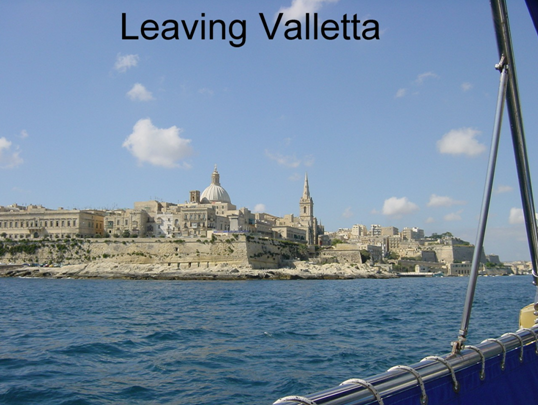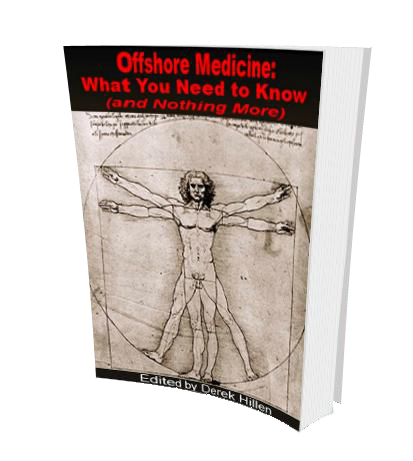- Boat
- Articles
- About
- Tehani-li Logs
- 2004
- Uligan Maldives
- Man, Oh Man, Oman
- Eritrea: The Nicest Place You’ve Never Heard Of
- Cruising Notes: Oman to Eritrea – From Pirates to Cappucinos
- Old Testament Sudan
- Egypt: Legend, Myth and Reality
- Thoughts on Cruising the Red Sea
- Greece: Civilization Again
- Montenegro
- Malta
- Sardinia, Italy
- Barcelona, Spain
- 2003
- 2002
- 2001
- 2004
- Contact
Malta
Malta. What do we really know about Malta? We didn’t see any falcons there and we knew less than nothing on arrival. After 450 rolly miles of “med-sailing” from Montenegro we finally arrived in Valletta, the capital of this island country and one of the newest members of the EU.
Geographically, Malta really looks like N. Africa. It is hot, with some hills and barren. Of course, we visited in August, the hottest and most barren time of year where the temperature regularly soars above 100 degrees Fahrenheit. Considering we were only 150 miles off the coast of Tunisia, this was not surprising. We had heard from many friends what a great place Malta is. It is so beautiful, it is so interesting, it is so wonderful, etc.
Well, we weren’t so sure and I think mainly this is because all previous reports had come from people who visited, and sometimes stayed, during the winter. Malta in August, like France and most of Europe, just shuts right down.
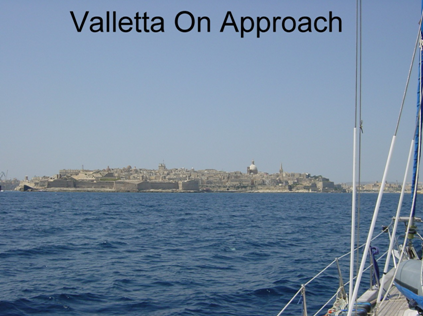
Our first night there we excitedly made it into the heart of Valletta for a good meal off the boat. By that time we were well used to the Mediterranean culture of shops and restaurants opening in the morning, closing in the middle of the day and re-opening in the evening. Malta would be the same, wouldn’t it? Nope.
At night in Valletta in August there are NO Maltese. We searched and searched for an open restaurant and finally found one, full of tourists. I asked the waiter if he was Maltese as the owner was obviously a Brit and he said he was. He told us there were no Maltese here and that there were only three restaurants open at night in the entire city! Unbelievable but true. Totally Deadville.
We returned to the city the next day in the morning hoping to find it different. There was more activity but again, most of the shops and places were boarded up, just not open. We spent two weeks sweating it out in Malta getting some varnish work done and came away with the conclusion; DON’T GO IN AUGUST!
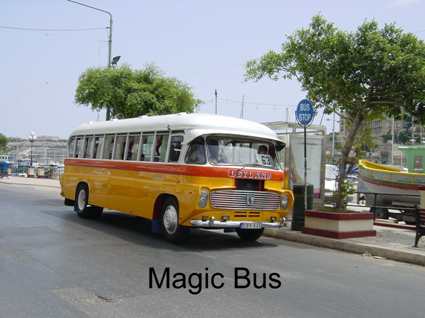
We berthed at Msida Marina and it was a good choice for us. Valletta was only a 10 minute bus ride away and there was a great supermarket a short distance away. Both the above statements require a qualifying explanation, however. First, the bus system in Malta is hysterical. They still use ancient British Leyland and Bedford buses with windows that open at the top a little, if at all and have absolutely NO AIR CONDITIONING! They are undoubtedly the perfect vehicles for 1940s Glasgow. In fact, most of Valletta was bereft of this new invention of air-con.
Some of the more modern shops and fancy restaurants had it of course, but by and large it was extremely rare. Most of Europe on this trip is like this despite the fact that air conditioning was invented by William Carrier (my hero) 101 years ago this July. Imagine sitting in the airless bus baking in the hot sun in this desert climate crowded with people as the claptrap vehicle noisily weaves its way down narrow bumpy roads, IN AUGUST! The drivers, like elsewhere in Europe, drive like maniacs and are usually quite ambidextrous being able to smoke, talk on their cell phone and steer at full speed around corners all at the same time.
Two weeks of Maltese buses left us with the phrase, “Shake and Bake,” ever present in our sweaty minds. The drivers all decorated their buses as well, with many plastic flowers, and family photos. Fortunately, there were always loads of religious icons to protect the sweltering, death-risking passengers from possible disaster that could await at the next corner depending on how the ciggie-cell phone juggling act was progressing.
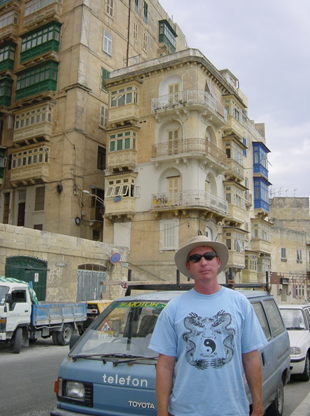
The supermarket was well hidden up a hill in the Msida neighborhood behind the marina. Msida is “mseedy” and we found nothing there of merit. We visited Grand Harbor Marina and it had a much nicer setting but was about 30 minutes out of town on the Shake and Bake line. There is a bus stop right outside the Msida Marina office with buses supposedly stopping there and taking you into town. Don’t believe it.
We once waited one full hour and no bus came! We discovered it was much easier and faster to put the dinghy in the water and chug down to the end of the marina across from the big church and take a bus from there, they ran every 3 minutes. On the provisioning side of things we had many different people give us many different directions to find this secret supermarket which, I kid you not, is hidden on a tiny side street upstairs above a Skoda car dealership! There are no signs to tell you where it is as everyone knows, right?
Here’s how to get there: Take your dinghy. Follow the main road behind the marina back until you see the diagonal road coming down to meet it. The supermarket is up the NEXT road (Antonio Sciortino). Tie the dink up near the launch ramp and walk up that road to the top. You will see a small market on the corner on your right. That ain’t it. Cross the road and now continue downhill in the same direction you came up. It will be on the first street you come to, Giorgio Mitrovich (a very Serbian name!).
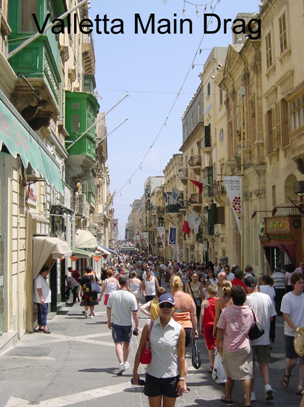
Other shopping and restaurants are to be had in Sliema, the next neighborhood over from Msida by the boat yard at Manoel island. There you can find Pizza Hut and McDonald’s, if you so desire. While we were there again both restaurants were absolutely packed with Pizza Hut even having a line out the door. Is this because there were no other restaurants open or are the locals getting tired of “fried rabbit,” the national dish? Take the dink over, it is a nice ride and you can make it under the little bridge that connects Manoel with Malta if you go slowly. There are many chandleries right near the bridge and two ATMs, very convenient.

The marina itself only cost us about $20 a night on the weekly rate, water and power included. Customs and Immigration are right next to the marina office so checking in is a piece of cake. The pilot tells you to go to the tiny and dangerous cement Customs dock to check in. Don’t be stupid. There are rocks close by and it is usually full of locals who are fishing from it anyway.
Just find an empty slip in the marina and you can then work things out from there. We did that right across from the Customs dock and every day I watched as boats came in and tried many times to tie up to that totally inadequate dock. Many times I shouted across to the newcomers to do what we did. Customs don’t care. It is your boat and if you screw it up following some bureaucrat’s rules he isn’t going to pay for it, is he? Malta didn’t stamp our passports (Greece did), there were no fees and when asked they politely told us, “You can stay as long as you like.
In fact, we found all the Maltese very polite. They are not loud, backslapping hail-fellow-well-met types but don’t take this apparent distance in human relations as hostility, it isn’t. The marina staff were also unfailingly polite and efficient. BUT DON”T ASK TO USE THEIR FAX MACHINE. We were full-paying customers and they had a fax machine right there in the office and would not fax out the one page I desperately needed even though I offered to pay for it. “No.” A little weak on service there, I thought.

While we were in Malta we decided to get the cap rails varnished. This is a big job as our cap rails (the teak trim that goes around the edge of the boat) are really fat. Our friend Tom, on Papagena, had breezed through Malta in April and told us about Michael Cachia, whom he hired to do some varnish on his beautiful boat. According to Tom, Michael’s work, “Left me speechless.” Well, he was right! Michael is Maltese and very nice. He spent a week sanding and varnishing our teak. He wasn’t cheap but he turned the sides into the Sistine Chapel of cap rails.
They have never looked so good. His number: 99 47 88 89. Beware of others, though. About five minutes after we pulled in to the dock another gent by the name of Peter S. came up to us and introduced himself as a carpenter and varnisher. I was a little suspicious as if a guy is good it takes a while to hunt him down because he is usually already busy on another job. After Peter left virtually every person on the dock warned us not to deal with him.
Even the marina staff said the same thing. One boater who had been there four years told me, “We’re trying to get him banned from the dock.” (!) Reason is he takes your money up front for a job and then disappears. His quote for our cap rails was very low too, which made me uneasy. Needless to say, we didn’t hire him and only saw him magically appear as soon as other new boats pulled in.
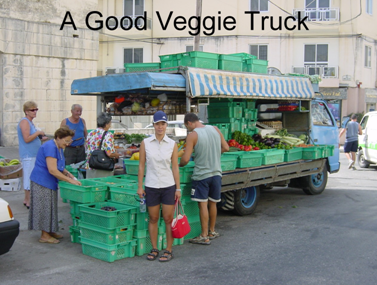
The same unfortunately can be said for the little veggie man. Malta, for some reason or another, doesn’t have many shops and the people buy their fresh produce from trucks that open up and park all around the neighborhoods. This truck came to the marina and he only talked, again, to the yachts that had just arrived. Our first day Ariel bought some fruit that was overpriced and of poor quality. She was so mad that she wanted me to take this guy’s picture and put it on the website! We don’t do that but would warn others to be aware of this shyster.
It always amazes us how some people will forever try and take the shortcut or screw you in a one-off deal. We sat in the marina for two full weeks and only bought from that geezer once because he screwed us. How much extra did he make off us, $5? How much would he have made off us from 14 daily purchases? Obviously, besides being a crook he isn’t very good at math.

A lot of boats come to Malta for the winter. This may be a good idea as then it would be cool and you could walk around, get to know the locals (as they would actually be there) and figure out how the place works. Malta oozes history. They say people have been living there for 7,500 years.
The place was alternately ruled by, Phoenicians, Romans, Greeks, Knights of St. John, Napoleon and even the Arabs took it over for a few centuries. Although everyone speaks English, most of the Maltese language, a mix of many things, comes from Arabic. I recognized a few words but overall it sounded like southern Italians speaking Arabic; bouncy but rough.
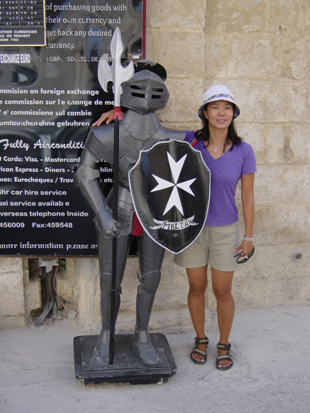
When our old friends, The Knights Templar, were booted out of Rhodes in 1522, they eventually came here and began to build up the impressive defenses of Valletta. Just a few decades later, the Turks realized their mistake and decided to come to Malta and snuff the Knights out for real. This resulted in the famous “Seige of Malta,” of 1565 which lasted a year. This time, however, God switched sides and the Knights won.
The place even has a rich recent history being, as they proudly proclaim, “The most heavily bombed target in World War Two.” Always a firm ally of Britain, Malta was attacked by the Italian air force a few hours after Britain declared war on Germany. Malta was in a strategic position for both sides and could easily disrupt supply lines to Rommel’s troops in N. Africa. Not long after the Italians began their bombing the more accurate Luftwaffe joined in as well.
In the beginning poor Malta only had three old WWI Gladiator bi-planes to defend herself. They were named, “Faith,” “Hope” and “Charity.” Every day these ancient and slow machines went up to fight it out with the much more modern Messerschmitt and Junkers. This was a very brave thing to do. Two of them were eventually shot down and destroyed but one, “Faith”, survived the war and was restored.
You can see her in the “Malta At War Museum” which I found very interesting, Ariel less so. In 1942, the King of England, George IV, awarded the people of Malta England’s highest honor, the “George Cross.” We saw that too in the museum. Needless to say, the relationship between the Maltese and the English is still very tight. Most of the holiday makers we saw were Brits. There are also more huge churches than you can throw a rock at. The pious could spend months exploring them all.
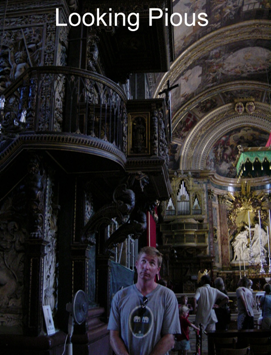
When it was time to leave we found checking out was painless. You can get duty-free fuel after you check out for half price. We paid 42 cents (US) a liter – the cheapest fuel in Europe. Be sure to arrange with either the fuel barge or fuel truck first. They need to call Customs and the official has to be there for the transaction. There was a $38 service charge for this. If you are getting a lot of fuel it is still cost effective. Malta still uses their old currency, the Maltese Lira. There were about 2.8 US dollars to one Lira when we were there.
Leaving Malta with a favorable forecast we had winds astern most of the way and actually sailed it! That was a first in the Med. However, on our second day out the wind increased to 30 knots steady and the seas built up. We were corkscrewing around and it was “rough as guts” as the Kiwis say. Ariel was sick as a dog and couldn’t get out of bed for most of that 24 hour period. Poor thing, she couldn’t even hold down a sip of water.
It was so rough we actually had to heave to (stop the boat by backing sails) just to run our water-cooled refrigerator. Otherwise the unit couldn’t pick up enough seawater with our 22 ton boat jumping around like a mule with a bee up its ass. We then decided to pull into Sardinia and get some rest. Cagliari, Sardinia at 330 miles away is exactly the half way point between Malta and our final destination, Barcelona.
